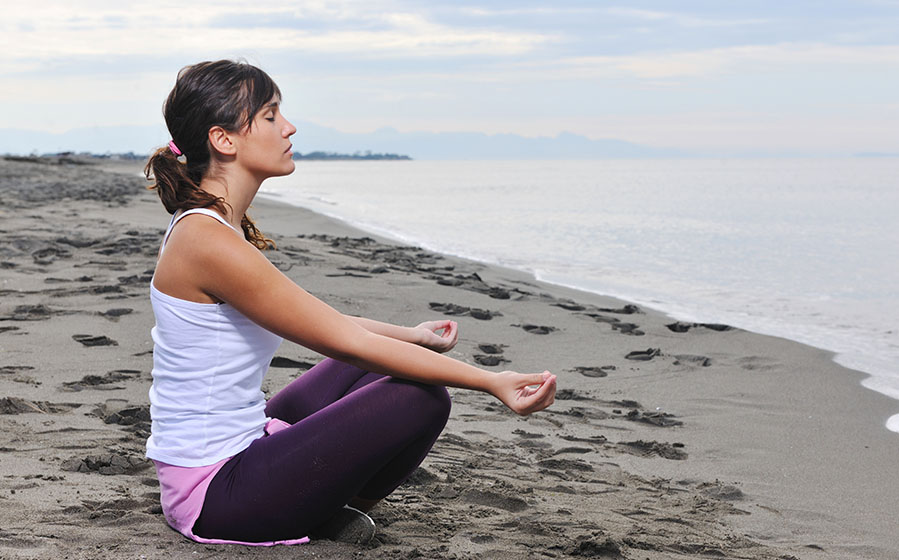Does yoga help with depression, as many studies claim? Is the data profound, the test groups large enough and the test period long enough that we can really tell?
Is it really new, that people try to use their breath, exercise and relaxation to improve their wellbeing? And after all, does it really matter what statistics say? What matters is how you feel, after you’ve left the mat.
So why another article about yoga and depression?
Because the number of people suffering from depression has risen by 18% from 2005 to 2015. Because only 50% of patients see a decrease in their symptoms through the use of antidepressants and psychotherapy. It’s simply time to give people some powerful tools at hand, that have the potential to improve their lives. It might work for many of them.
But before we dive deeper into the specifics of yoga, let’s take a closer look at some very concerning data about the high occurrence of depression, at the nature of this illness, and why it it has found its place amongst the most widespread diseases in the world.
Some figures on depression
Early 2017 the World Health Organization (WHO) published the latest figure on how widespread depression really is:
- 300 million people worldwide are suffering from this mental illness, which makes it the world’s most common illness
- According to WHO the number of suicides by people with a history of depression is only short of 800.000 per year. This is despite an all time high of prescriptions for antidepressants
- For adults under 45 depression is the leading cause of disability
- The dropout rate of the so called conventional care, which includes the use of antidepressants and a range of psychological interventions, lays between 20 and 47%
- Reasons for the dropouts are the high costs of office visits, duration of the treatment, social stigma, insufficient therapeutic alliance with the clinicians, and intolerance to the drugs’ side effects
- 50% of the people diagnosed with depression don’t even receive this conventional care to begin with
The recent rise in the amount of research into how yoga can help to ease symptoms of depression, underlines the need for alternative treatment methods to the wide spread prescription of medical drugs, which alongside psychotherapy is the main treatment vulnerable people receive. Both make the patient reliant, on the expensive drugs and on their therapist.
So what is actually happening in the mind of a person suffering from depression?
Depression is a mood disorder. Our mood is regulated by the nervous system. While the finer mechanisms that cause depression are very complex and are still in the process of being researched in more detail, stress plays a big role in the outbreak of mental illnesses, of which the most common ones today are depression and anxiety.
Therefore it is not utterly surprising that the number of people diagnosed with depression has been rising in the last decade by 18% (2005-2015).
Factors this can be attributed to are the increasing demands in our jobs, demands that technology brought to us, like the expectation to be always online, to check emails outside of the office. Some stress is not to be avoided. Full stop. But not only is stress imposed on us from outside. Much of it is self-inflicted. We want to have it all: success in our job, being a perfect parent, partner, child, friend. But it’s also what society expects from us. Multiplied with the pressure caused by social media showing us our friends’ perfect-looking lives – it easily becomes overwhelming.
The Window of Tolerance
Psychiatrist Dan Siegel describes mental illnesses by the use of the Window of Tolerance, which relates to the optimal zone of arousal. In this state, we’re able to manage our everyday life.
If outside of this named Window of Tolerance, our body reacts with gearing into survival mode, which leaves us with the options of fight, flight or freeze. Depression means we’re low in energy, which is a state of hypoarousal. On the contrary, hyperarousal shows itself as anxiety. Siegel advises to practice mindfulness to get back into the said window, our zone of wellbeing. This can entail grounding exercises like feeling one’s feet on the floor, slowing down our breath, talking a walk and other techniques.
Often the prescription of antidepressants is not sufficient for people to manage their daily lives.
But the tide is shifting and therapists are on the rise who integrate mindfulness into their treatment, and advise their patients on physical exercise, grounding, relaxation and breathing practices.
And here is where Yoga comes into play
Yoga derives from the Sanskrit word for ‘Union’ which mainly refers to the union between mind and body.
Let’s look further into the different elements that make up a yoga practice and how they can contribute to the ease of depression symptoms. As most studies are conducted using Hatha Yoga, the below outline is also referencing this traditional Yoga style.
- Breath. The breath is an extremely powerful tool in unifying body and mind and in regaining control of our mind. It is also one of the main tools therapists advise their patients to use if they feel out of balance. Breathing exercises can slow down racing thoughts or help us to change perspective when dark thoughts are pulling us into a hole. Sitting up straight, closing the eyes, and taking a few slow, long and deep breaths is often enough to reclaim control of our thoughts.
- Exercise. It’s known for a long time that physical exercise has tremendous benefits for our mental wellbeing. A new study published in The US Public Library of Medicine shows once more that any aerobic exercise that gets your heart rate up, lifts the mood (short term), improves concentration (short term) and memory (long term).
- Relaxation. Relaxation, mindfulness and meditation trigger the parasympathetic nervous system which is responsible for the rest and digest function of our body. In our daily lives, when we’re out and about and especially when we’re tense, our body is in a constant state of stress. This state of is steered by the sympathetic nervous system. Relaxation in form of a guided meditation or some simple calm breaths is our tool to consciously make the switch in our head and calm our minds.
Yoga combines the above three elements to which doctors and scientists attribute a positive effect in the ease of symptoms of depression.
Another important factor more specific to Yoga, is the practice of compassion and self-awareness. Turning the senses inward, listening to yourself instead of others. People suffering from depression were often found to be very demanding towards themselves. In many cases they have never had a nurturing voice in their lives teaching them to listen to their own feelings and sensations in the body.
Yoga teaches exactly that. Yogis know, that they should treat themselves with the same self-care during the asanas on the mat, as in their behaviour towards others and themselves off the mat.
Body-Mind connection in the 19th Century
Whilst the interest in the connection between body and mind is currently trending and goes back thousands of years in India, this knowledge is not new in the West either. Research about this relation was already conducted by renowned psychoanalysts in the end of the 19th century. Wilhelm Reich, a disciple of the better known Sigmund Freud, pointed out how breath can soothe the nervous system and the importance of balancing body and mind for overall health. This connection works in both directions: physical pain can be caused by mental issues and mental health can be affected by physical restrictions.
Recent studies on Yoga and their challenges
Most of the studies show indeed a positive impact on people suffering from depression.
A study from the Boston University (published in the Journal of Alternative and Complementary Medicine in May 2017) for example emphasizes that yoga contributes a great deal in the decrease of the symptoms of depression. After a three-months-period of regular Iyengar Yoga practice all 30 participants of the study declared their depression score to be 50% lower than before. The yoga practice comprised two (group 1) and three classes (group 2) a week plus individual home practice. The study also showed that the people practicing more often per week lowered their score further than the rest.
In another trial with 38 people (68% female and 32% male, (published in PLOS, March 2017) with major depression of mild to moderate severity was shown, that the 20 people practicing Hatha Yoga for 90 minutes twice a week over a period of eight weeks, showed lower depression scores than the control group who attended classes in attention control education. A statistically and clinically significant reductions in depression severity was demonstrated.
Having said that, the studies so far entailed only small test groups. Larger sized test groups and long term trials are still missing. Therefore no definite conclusion on the role of yoga in alleviating symptoms of depression can be drawn yet.
Also, most of the studies focused on women. A recent study with mainly male veterans suffering from severe PTSD has demonstrated that there are many caveats that need to be taken into consideration in the trials. While all the veterans from test group have seen an improvement in their wellbeing, key factors like motivation, recruitment time, and especially a focus on the individual’s needs and specific problems are said to play a big role in the outcome of the study.
So what to do until we know for sure?
Experts have promoted the benefits of physical exercise, relaxation and breathing exercises for people with mental illnesses, based on the nature of our mind’s mechanics. While this bodes well for a final positive judgment on how yoga can help with depression, there are some aspects everyone entering a yoga class should be aware of, especially those with a history of depression.
A safe Yoga practice is key
It is of the utmost importance to find the right yoga style and a teacher that resonates with you. People with depression or other mental diseases should for example stay away from deep visualisations as they can trigger trauma.
It’s essential that the teacher respects boundaries. These include physical boundaries like touching students without asking first, as well as making claims of unrealistic benefits of yoga, or a lack of responsible guidance through meditation and physical postures.
Instructors need to be aware that the choice of words carries a lot of weight and that it can trigger trauma. It’s their responsibility to create a safe space for the student to go inwards and find out what makes them feel good.
More education for yoga teachers is advised, that gives them the knowledge and psychological insights to protect the students as well as themselves. Fact is, most of the time yoga teachers simply don’t know the attendants’ background and state of mental health. Therefore an unsafe yoga practice can have the exact opposite effect on the student than the one they stepped into the yoga shala for.
Let’s experiment with what makes us feel good
It’s encouraging to see that healthcare professionals integrate elements of yoga into their treatment of patients in a growing rate, and give them tools that they can try on their own. In the end, the outcome for every person living with depression will be different, no matter if a study has proven a benefit or not. Due to the complexity of the mechanisms of depression, we will never be able to say that yoga works for everyone.
So let’s keep the discussion open, the studies coming and let’s hope that as many more people will be introduced to the beautiful practice of yoga to find out for themselves how they feel about it.
Disclaimer: It’s strongly advised for any person with a history of depression who is interested in starting a yoga practice, to consult with her/his therapist first.






